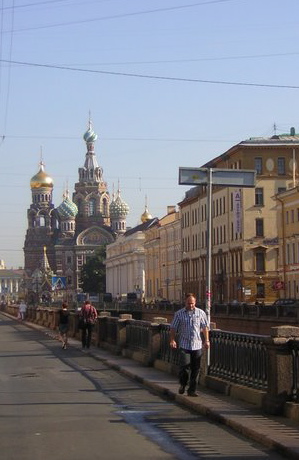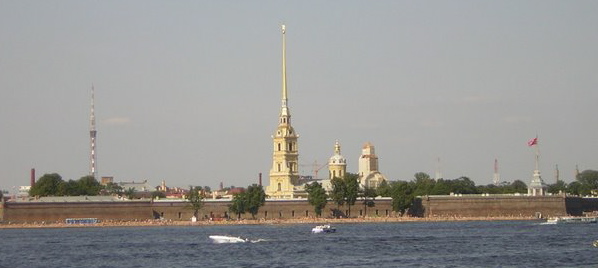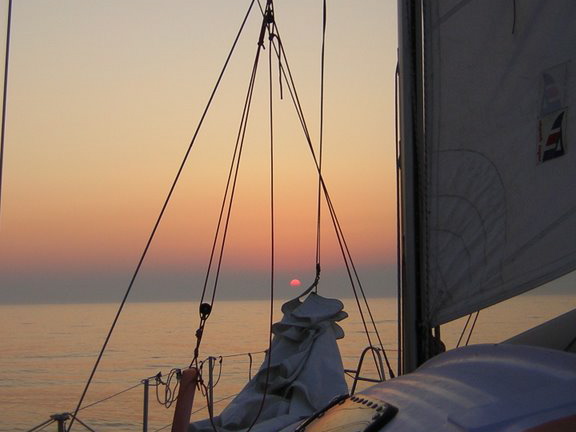
| IMRAM 2007 - étape 5 |
|
Helsinki - St Peterburg
(9-11/8)
 It is Gunnar's last day on board. For days already, he had been fine-tuning a plan to bake cinnamon buns at midnight, to welcome our new crew. But ... they had decided to spend the first night in a hotel! The buns are happily consumed by those on-board, aptly assisted by Maciek from the neighbouring boat, who turns out to know Sebastian Lopienski from a regatta a few years ago. In the morning, the new crew (Yvonne, Helen, Ruben and Haude) arrives, with a staggering number of bags ... We spend the day refueling, checking the rig, cleaning the mast rails, storing the dinghy, buying food supplies, picking up an Estonian chart portfolio, visiting the town etc... And then ... a bit before dark, departure for St Peterburg. We follow at first the scenic Finnish internal route, enjoying a truely remarkable salmon dinner. Soon after the TSS with its string of cargo ships comes in sight, we stay North of this for now. We're lucky with the wind: mostly between close-hauled and beam-reach, enabling us to sail rather than motor. And then, on August 10th at 2:52 UTC comes the long awaited moment of entering Russian waters, as required between the 2 entry buoys on the GOFREP Eastern Reporting Line at 26°30' E. The event is accompanied by a strikingly beautiful sunrise over Gogland, the first Russian island we pass by (the name is said to be a transformation of Hochland, or "high land", even if only 173 m high). The maritime borders in this region are surprising: Russian territorial waters begin well to the W of the straight line connecting the land borders between Russia and Finland and between Russia and Estonia. As a result, there is still 130 nm (and 150 nm on our return) to go to St Peterburg. Another interesting feature is that the entry buoys, just like the cardinal marks that delimit forbidden zones, exist only on the charts, not on the water. With the numerous islands, such as Gogland, it is fortunately not a problem to position oneself using bearings and radar. GPS doesn't seem to be the method of choice here since there regularly is no adequate signal, and the charts are anyhow not drawn in the WGS84 datum. On entry, we make the first of a number of calls with the Russian coast guard. They will keep tracking our progress until arrival. Every few hours, we are handed over from one coast guard station to the next. The coast guard turns out to be friendly, provided one sticks to the rules, and they consistently wish us a good watch. The name of the game here is to follow the fairways, without entering the TSS nor straying into the forbidden zones alongside the TSS. In addition, it is forbidden to approach, left alone land on any island before Kotlin. To add some spice to it all, we were warned in advance that a mistake costs 100 €. Apparently, we managed to stay clear of all traps and reached Kronshtadt in the night. There, the Russian coast guard tried to guide us to a waiting mooring in town, between Fort Constantine and Fort Alexander, but the charts turn out to be perfectly right in that area is truely foul ... After a 2h30 long, almost comical ballet with the coast guard, we decided to continue to a waiting area outside Kronshtadt and anchor there awaiting the morning and the opening hours of the customs, who nowadays are at the Sea Terminal in town. At the customs, we meet Vladimir Ivankiv thanks to whose priceless services, the formalities are completed in an hour. Two hours later, we arrive at the St Peterburg River Yacht Club, where there is indeed mooring available, as promised. The harbour is guarded day and night, impeccably clean showers are available nearby, and the bus stop is only a short walk away. A Finnish and a Lithuanian boat are already in the harbour and a day later, Maciek and a Dutch boat arrive too. When we came in, the flags of the foreign boats were hoisted at the sailing club, but soon after our arrival, they take them down ... they didn't have a Swiss flag! In the evening, we visit the town a first time, spending some time looking for a chic Georgian restaurant which turned out to be not only closed, but the building in which it stood had been demolished. The day after (12/8) we go to the Hermitage, admiring Rembrandt, Matisse, El Greco and every artist one can imagine, as well as several goden rooms constructed in the style of Catherine the Great and in the evening to the ballet (Swan lake, in the Alexksandrinskii theatre, performed by the troupe of the conservatory). On the 13th, most of us visit St Peter and Paul  and the Spilled Blood cathedral, and ont 14th, we go to Peterhof, another understated palace to suit the simple taste of Peter the Great. St Peterburg - Vergi (15-16/8) Leaving St Peterburg is argueably more thricky than entering: once one has passed the customs in town, there is no(cheap) way back since the single-entry visa for entering Russia will have expired. Fortunately for us, the weather forecasts announce settled weather for a number of days to come, the boat looks in good shape and we have ample supplies of Diesel. Exit through the customs turned out to be a simple affair, taking less than 1h. On the way to the Eastern Reporting Line, we stay mostly on the North of the fairway, a somewhat longer route, but this area is much less infested with forbidden zones, one merely crosses 2 TSSs which are not much used. The only event worth reporting is the coast guard making contact with us in the middle of the night not via radio, as they had so far done, but using ... green signal rockets. Maybe we had missed a call in Russian? At any rate, they are perfectly friendly and wish us a good trip. They keep a close watch throughout though, to the extent that they observe that we are at some point using the motor in addition to the sails in order to cross a TSS at right angles, wondering whether we carry the mandatory daymark (a black triangle). And then, on August 16th at 11:36 UTC, after a final radio call to the Russian coast guard, we leave Russian waters, passing again between the virtual entry buoys on the GOFREP Eastern Reporting Line. All of a sudden, no need anymore to know our position to better than 1 nm (a strange feeling) and a good occasion for an aperitif. We proceed to Vergi, Estonia, only 25 nm away, we could have gone there much more directly, but the Russian Coast Guard won't allow entry or exit via the (disputed) border with Estonia, one may enter and leave Russian waters only through the central GOFREP international waters zone. In the tiny port of Vergi, a particularly friendly Estonian coast guard officer awaits us, surprising since there are no other visitors and the activity seems low otherwise, to the extend that the main jetty has been dismounted. Clearing the Estonian customs is a matter of minutes. That being done, the officer switches to more serious matters and points out where the showers are, where to go for a walk etc...! Near Vergi are some small villages, with manifestly good restaurants. The delicious mushroom salad and breaded sardines, which the restaurant had put into a box for those who didn't leave the boat, are still engraved in my memory ... and this was only the first of a number of positive gastronomic experiences in this country. Vergi - Tallinn (17-18/8)  A priori a trivial leg, which started out with some sight-seeing in the natural reserve near Vergi. But in the middle of the night, on approach of Tallinn, there is first a Mayday call from a sailing boat, not far from our position. The boat had broken its mast, there was a steady 6 Bf breeze combined with the swell of the near-gales and gales a bit further to the W. The Estonian coast guard took charge and the boat later returned on its own to Finland. Soon after, we feel like the pirates in Asterix in Britain as we are overrun in the pitch dark by a fleet of sailing boats, several of them without any lights, many with barely visible lights. They turns out to be taking part in an annual regatta from Helsinki to Tallinn, not announced on the Navtex. The first boat crosses in front of our bow within 2 boat lengths. Soon after, we're on all sides surrounded by sailing boats and we remain on alert for hours, watching for boats that may suddenly tack for tactical considerations, not realising that we're not taking part in the race and that the Imram doesn't tack anywhere nearly as easily as a regatta boats! We probably tacked as many times that nights as during the whole rest of the trip. Our host port was Pirita, previously host to the sailing events of the 1980 Moscow olympics. Tallinn is a laid back capital with dozens of charming coffee shops and splendid restaurants. In between, one can visit art galleries, churches and admire the medieval architecture, interspersed with Art Nouveau and some very modern. A long walk back to the harbour included a stop at the site of the singing revolution, where in 1988 more than 300'000 Estonians gathered to sing and demand independance. Rob had the novel experience of having to wait while crew members toe nails dried after a pedicure. Tallinn - Kuressaare (19-20/8)  En route we were warned of controlled explosions by German NATO warship Datteln, but they do not (yet!) concern us. The approach to Kuressaare port at night was stunning: a 2900 m long, 24 m narrow and at most 2.6 deep channel, at the end of which we could see the floodlit castle, a thirteenth century stone castle which is the best preserved in the Baltics. The very friendly harbour master has bicycles for rent, is available day and night for advice, and has impeccable installations, Oskar clearly is a class apart. The castle, built from the late 12th century onwards, has largely been restored and now houses a variety of exhibitions. I was fascinated by those covering the history of Saarema in particular and Estonia in general. In the Middle Ages, the area was under German and Danish rule. The castle belonged to the bishop, until he was evicted at the time of the reformation. During the 2nd word war, Saarema was taken over by the Soviets (1939), then conquered by the German (1941), then recaptured by the Soviets (1944). Many fled to Sweden, following the route we were to take a day later, but under far more precarious conditions. The place remained under Soviet control and some inhabitants have been kept in Soviet prison camps until the mid 1950s. Seeing these exhibitions makes it clear why so many Estonians insist on not being "approximately Russian". Estonia was in my view the most surprising part of the tour: a country in the process of making a new start, and doing so with great imagination and unbelievable energy. It shows while sailing, a cruising guide has been published, chart portfolios of good quality are available, the guest harbour of Kuressaare has greatly been improved. And yet, places like Vergi manage to retain their simplicity and charm. Also Kuressaare remains little visited, perhaps due to the access channel? Manifestly, Estonia hasn't yet been discovered as a cruising destination. We also meet Alex and Ursula of the Silmaril, who where moored next to us in Helsinki. They had the same problem as us of having an empty gas bottle, and they had located a place where the bottles could be refilled ... coffee flowed again! Kuressaare - Gotska Sandön (22-23/8) Estonia takes its border control serious and since we are about to leave the country, two Estonian coast guard pay us a visit. Strictly speaking, they would have to escort us out of the territorial waters, which we were to leave only many hours later, but they take our word for it that we really will go to Sweden and explain that these customs procedures will soon be a thing of the past. This time the warnings of controlled explosions, now from NATO warship Middleton, directly concern us since the site of the explosions is precisely on our planned path out of the Bay of Riga, a bit North of the TSS. Using an alternative track through much more shallow waters, we avoid the site (by 3 nm) and in addition shorten our route by several miles. This probably made our arrival a bit faster, but the main reason for arriving early in Gotska were two stretches of a couple of hours each, consistently at 8 knots on a beam reach in almost flat waters, flying through a pitch dark night, an experience in itself! Gotska Sandön emerges out of the fog when we're not even half a mile from the coast, with just 8 m of water under the boat. While making the tour around the island via the South, towards the more sheltered W coast, we pass by one of the seal colonies the island is famous for. Otherwise, it seems to be an endless yellow sand beach with plenty of bright green forest inland, hard to imagine this is at 58°20' N! Sunny weather during the day, used by most for making a hike, and for swimming by the rest.  Gotska - Nyköping (23/8) Departure shortly before midnight, Gotska again shrouded in the mist, and arrival in Nyköping in the afternoon after a passage through the Southern part of the Stockhom archipelago. Sadly, the shipyard turns out to have no berths left for the winter; in the winter, as a rule, the water freezes here and all boats are taken ashore. Each boat therefore has its own berth, and visitor berths are rare, they need to be reserved several months ahead of time. After some discussion, the boat remains in the Nyköping guest harbour, awaiting transport further South in a couple of weeks. Good occasion to use the remaining time to visit Stockholm, Norrköping and Linköping. In total 815 nm from Helsinki * * *
<< Etape précédente | Home | Etape suivante The
Imram Voyage 2007 - Integral 12.50 - ACAPELA, oct 2007 |
